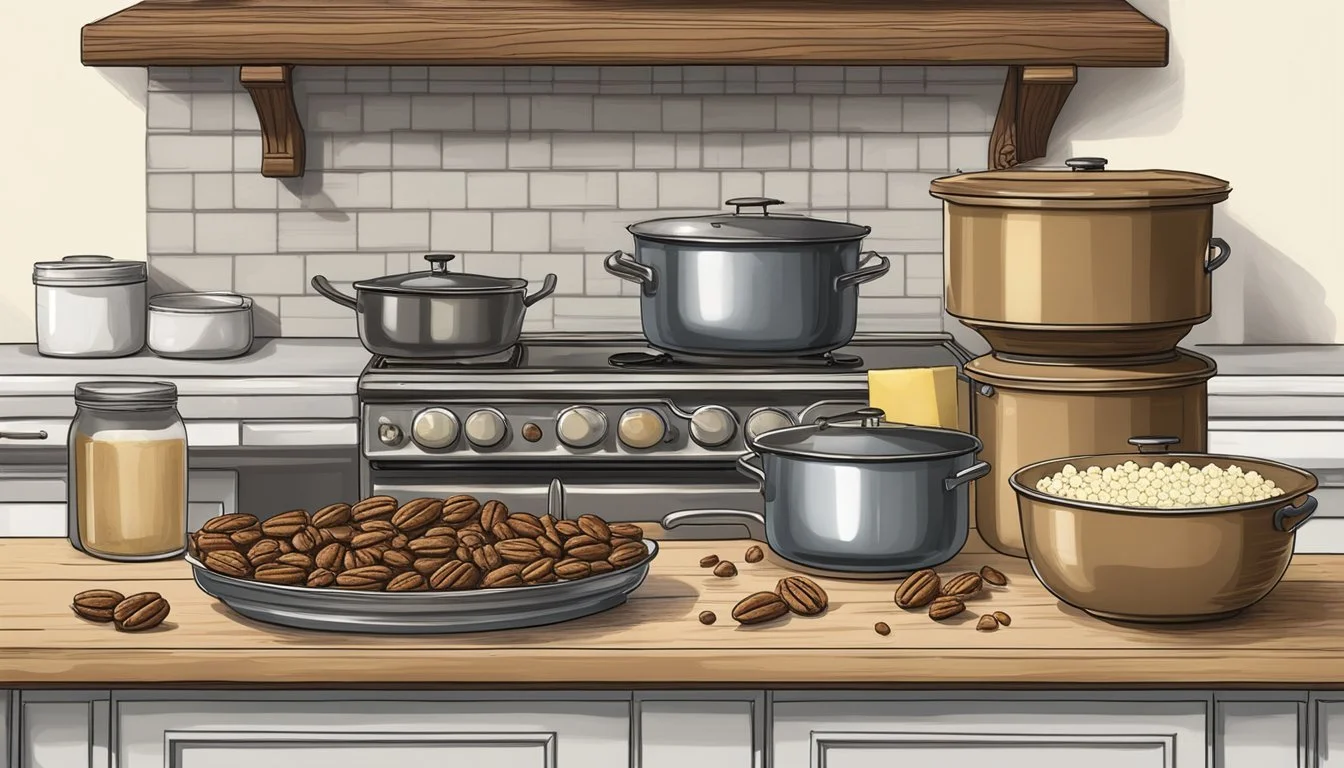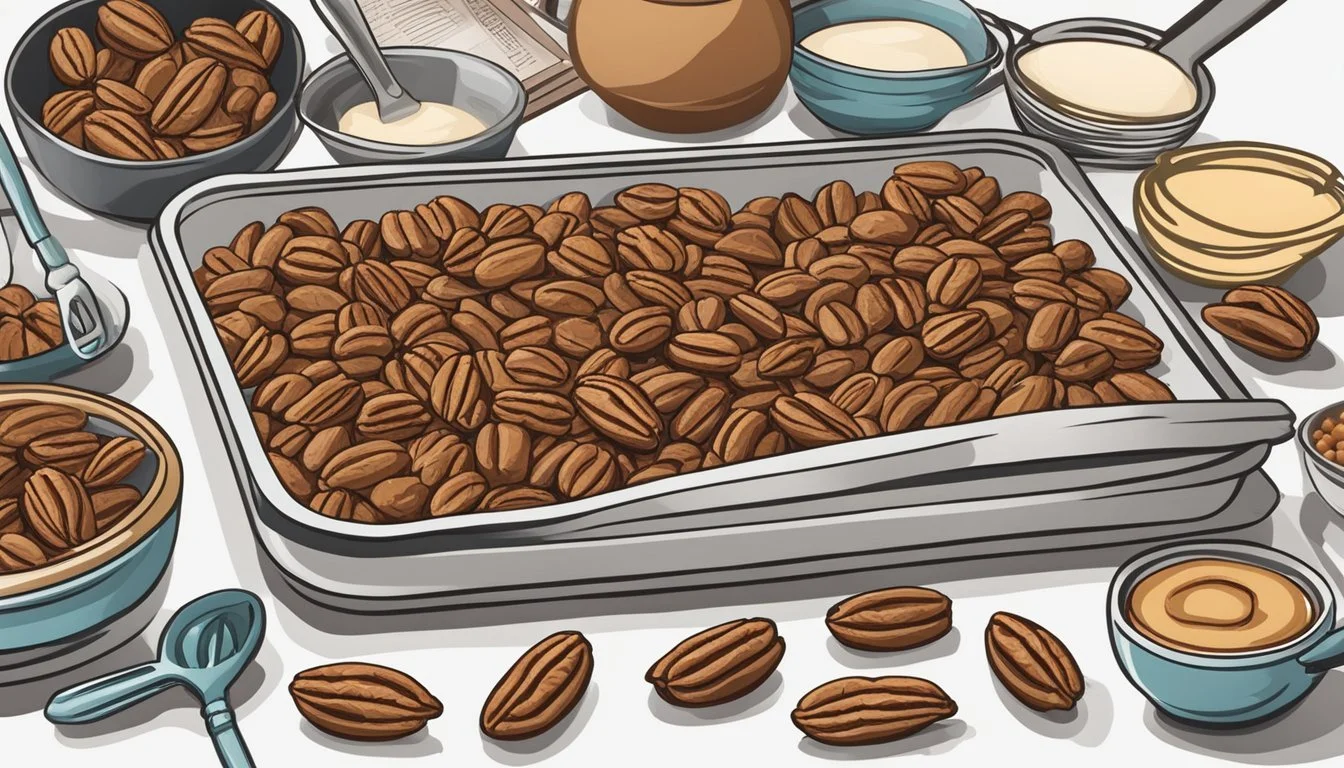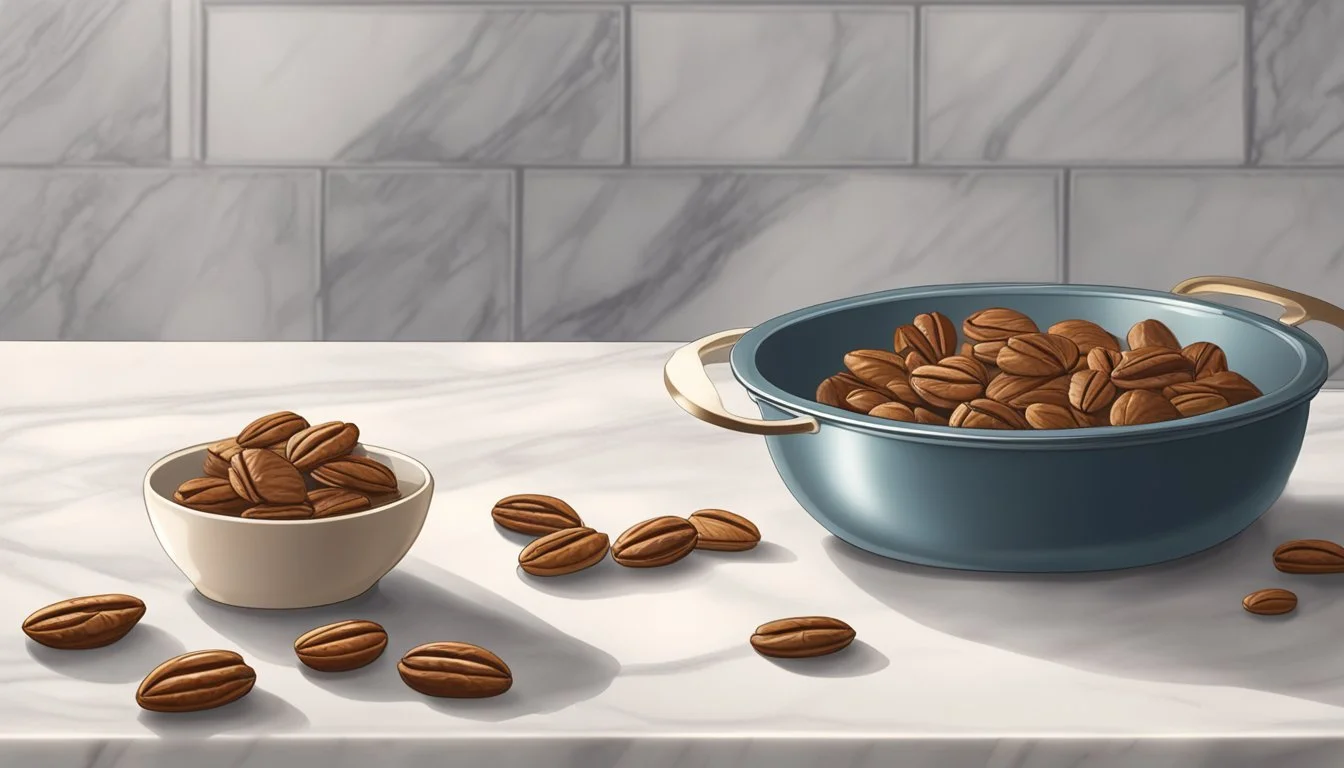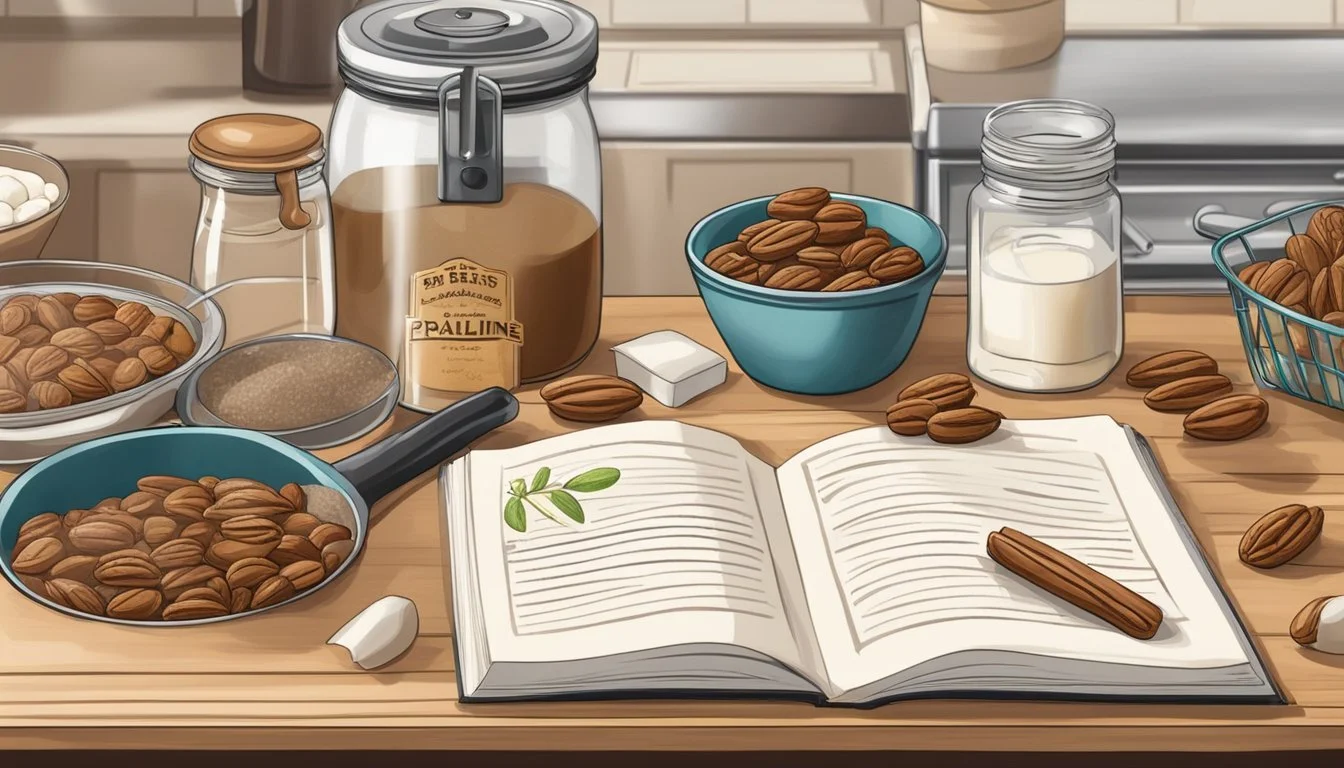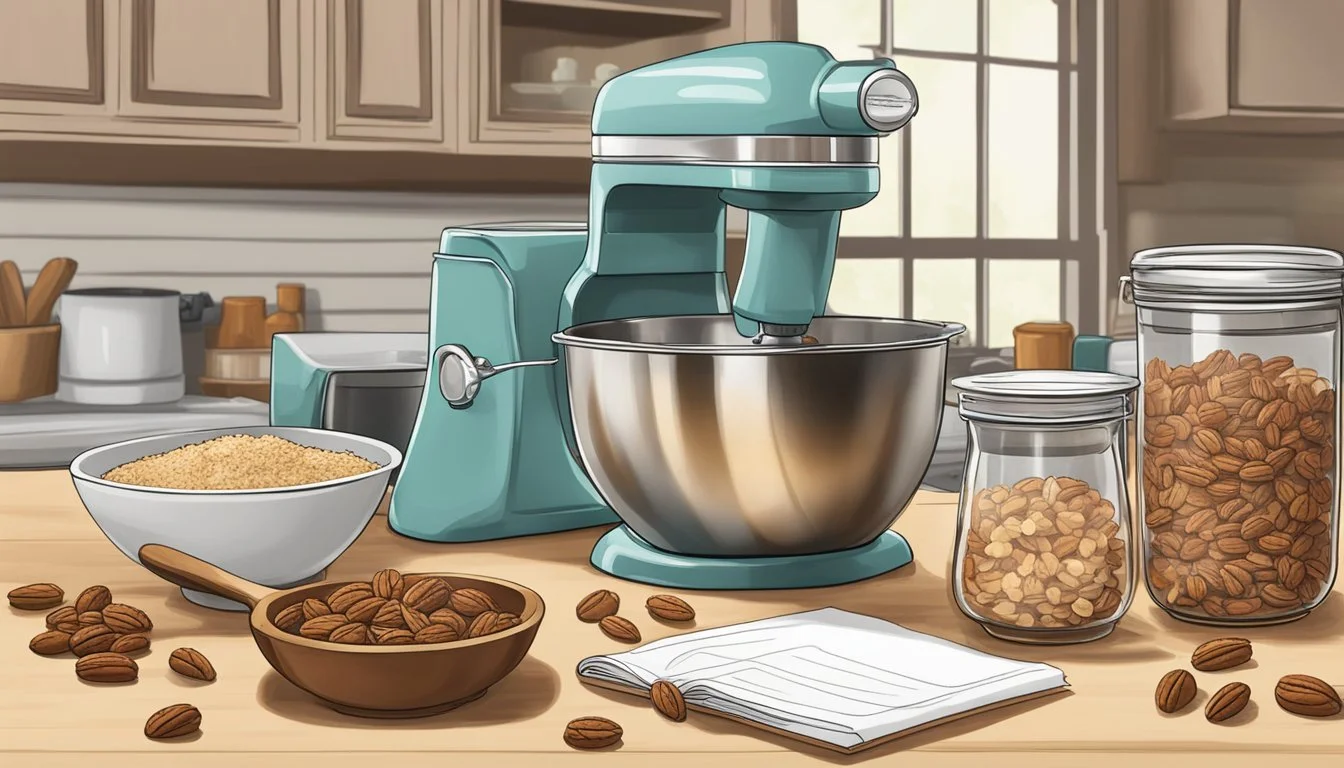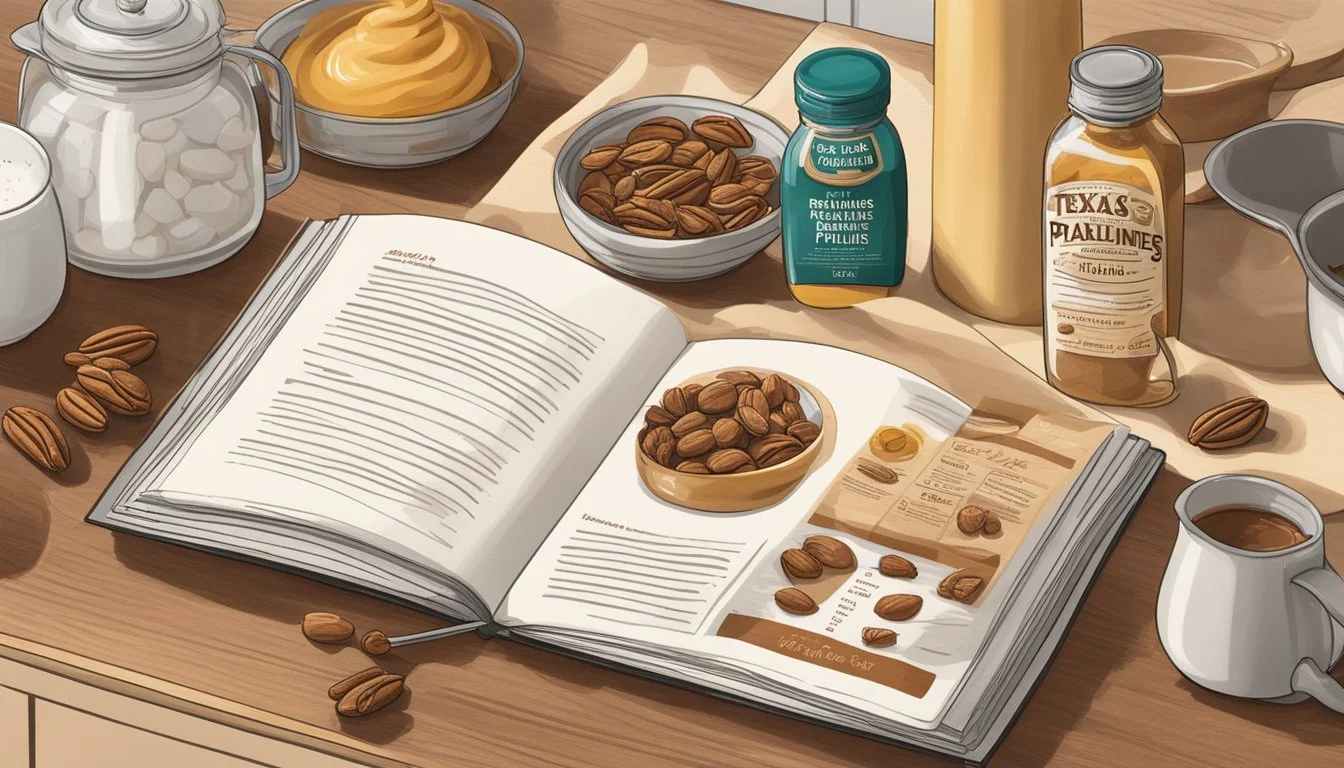How to Bake the Perfect Texas Pecan Pralines
Your Ultimate Recipe Guide
Texas pecan pralines carry with them a legacy as rich as their flavor. These Southern delicacies, characterized by their creamy consistency and nutty crunch, have been a staple in Texan confectionery for generations. It isn't just the taste that makes the pecan praline special; it's also the simplicity of its ingredients and the precision involved in its creation. Crafting the perfect pecan praline is an art that marries the natural sweetness of pecans with the caramel-like blanket of cooked sugar and cream.
The foundation of any good pecan praline is in the quality of its namesake nut. Pecans, native to Texas, are not just a beloved ingredient but a symbol of the state's agricultural pride. The art of praline-making demands a watchful eye and a patient hand, especially as the mixture reaches the critical soft-ball stage where sugar, butter, and cream come together in harmonious blend. Temperature control is crucial to prevent any graininess, ensuring that each bite of a praline yields a smooth, melt-in-your-mouth texture that's studded with the satisfying crunch of pecans.
Beyond the technical aspects, the best pecan pralines are often those that follow time-honored methods. From the bustling streets of San Antonio to the tranquil towns that dot the Lone Star State, each kitchen spins its own version of this traditional sweet. The pecan praline remains a revered treat within Texas and beyond, inviting bakers to effort the creation of a confection that's as delightful to present as it is to savor.
History and Origin of Pecan Pralines
The pecan praline has a rich history rooted in the cross-cultural culinary dynamics of the New World. Born from the traditions of French settlers in Louisiana, the praline owes its creation to the marriage of Old World confectionery techniques and New World ingredients.
In France, the original praline was a confection made from almonds and caramelized sugar. The French settlers who arrived in New Orleans adapted this recipe using Louisiana's native pecans, a twist that gave rise to the pecan praline. These settlers, adept in the art of sugar refinement, brought their confectionery skills to their new home, blending European culinary methods with local flavors.
Texas Pecans: The introduction of Texas pecans to the praline recipe further refined the sweetmeat's flavor profile. Texas pecans, with their rich, buttery taste, were particularly well-suited for caramelization and became an essential component of the praline recipe, setting the standard for today's beloved treat.
Below is a brief overview of how pecan pralines became a cultural hallmark:
French Roots: Emerged from French confectionery practices involving almonds and sugar.
Louisiana Adaptation: Native pecans replaced almonds due to their local abundance.
Texan Influence: Texas pecans elevated the confection with their distinctive taste.
Pralines quickly turned into a sought-after delicacy in the South, synonymous with Southern hospitality and warmth. Their popularity has endured for centuries, making pecan pralines an integral part of Southern, and especially Texan, culinary tradition.
Essential Ingredients
The success of Texas Pecan Pralines relies heavily on high-quality ingredients. This section will detail what to look for in each essential component to ensure your pralines are as authentic and delightful as possible.
Selecting the Best Pecans
Pecans are the heart of praline candy, and their quality is paramount. One should select fresh, whole pecan halves that are uniform in size and have a rich, buttery flavor. These nuts should be free from any bitterness, which is often a sign of staleness.
Understanding Sugars
The sugar combination in pralines is critical as it contributes to the texture and flavor profile of the final product. A mix of granulated sugar and light brown sugar is often recommended for a balance of sweetness and a hint of molasses flavor. Using pure cane sugar ensures a smoother texture in the praline mixture.
Dairy Products in Pralines
Dairy adds creaminess and body to pralines. Unsalted butter is preferred to control the praline's saltiness. Either heavy cream or a blend of cream and full-fat milk can be used, offering a rich consistency to the candy. Additionally, a dash of salt can be included to balance the sweetness and enhance the overall flavor.
Equipment Needed
Baking the perfect Texas pecan pralines requires precision and the right tools. Carefully measuring temperature and ensuring even heat distribution are critical to achieving the desired texture and consistency.
Candy Thermometer Importance
A candy thermometer is indispensable for praline-making. It allows the baker to monitor the sugar mixture's temperature precisely, ensuring that it reaches the soft-ball stage, typically around 236°F (113°C). Achieving this temperature is crucial for the texture of the pralines.
Choosing the Right Pot
Selecting a suitable pot is just as important as using a candy thermometer. A heavy-bottomed pan or heavy saucepan is ideal because it provides even heat distribution, preventing the sugar from burning. This type of pot is also sturdy enough to handle the high temperatures of candy making without warping.
Baking Sheet: Used in combination with parchment paper to place and cool the praline candies.
Parchment Paper: Prevents sticking and makes clean-up easier.
Wooden Spoon: Necessary for stirring, as it doesn't conduct heat and is easy to handle.
Preparing the Pecans
When making Texas Pecan Pralines, the quality of the pecans can define the richness of the final treat. It's advisable to select fresh, unblemished pecan halves for a visually appealing presentation. The pecans' contribution goes beyond just their look; they are also responsible for the characteristic nutty flavor, which is essential for authentic pralines.
To begin, one must measure the pecans accurately. Typically, a recipe could call for anywhere from a cup to two cups of pecan halves, depending on the batch size.
Toasting the Pecans Toasting the pecans is an optional but recommended step. Toasting enhances the nuts' natural flavors and adds depth to the candy's taste profile. Below is a simplified process for toasting:
Preheat the oven to 350°F (175°C).
Spread the pecan halves in a single layer on a baking sheet.
Toast in the oven for about 10 minutes, stirring once to ensure even toasting.
Note: Keeping an eye on the pecans is crucial as they can quickly go from toasted to burnt.
After toasting, let the pecans cool before incorporating them into the praline mixture. This wait ensures that their texture remains firm and they retain the freshly toasted warmth. Toasted pecans not only provide a more robust flavor but also contribute to the pralines' overall texture.
Handling the pecans with care at every step ensures that their delicate presence is preserved in both the process and in the enjoyment of the final praline.
Praline Mixture Preparation
To start making the Texas pecan praline mixture, one needs a combination of sugars and wet ingredients. The primary components include sugar and brown sugar, which contribute to the praline's sweetness and color. Brown sugar, containing molasses, adds a rich flavor. The recipe also calls for light corn syrup, a thickener that also prevents crystallization.
For creaminess, heavy whipping cream is essential; it should be combined with the sugars and corn syrup. A dash of water can be added to adjust consistency. The incorporation of butter into the mixture adds richness and smoothness. As for flavoring, a teaspoon of vanilla extract is crucial for the pralines' distinct aroma and taste.
Ingredients Quantity Purpose Sugar — Sweetness Brown Sugar — Sweetness & Color Heavy Whipping Cream — Creaminess Butter — Richness Vanilla Extract — Flavor Light Corn Syrup — Thickness Water Optional Consistency
Cooking should commence on medium-high heat, carefully watching the temperature. One should aim for the soft-ball stage (around 236°F to 240°F), using a candy thermometer to track the heat accurately. Consistent stirring is key to ensure even heating and to avoid burning the mixture. The process usually takes about 20 minutes.
After reaching the desired temperature, the mixture should be removed from heat. It's critical to let it cool down slightly before adding the pecans and vanilla. This allows the flavors to meld and the texture to set properly. Cooling to the right temperature, around 170°F, is vital before stirring in the vanilla extract and pecans, as it ensures a glossy and smooth finish.
The Cooking Process
The precise management of temperature and timing combined with consistent stirring are crucial to crafting the perfect Texas Pecan Pralines. Careful attention ensures the candy reaches the desired texture and flavor.
Temperature and Timing
The use of a candy thermometer is essential to monitor the temperature, aiming for the soft ball stage, which is between 235°F and 245°F. The cook time can range from approximately 20 to 25 minutes depending on the target temperature, with pralines usually hitting the soft-ball stage around 236°F to 238°F. The cook should not rush this process, as accurate temperature control is the backbone of successful candy making.
Stirring and Consistency
Stirring constantly is another key aspect of the praline making process. This action prevents the sugar from burning and ensures an even texture in the final product. It’s crucial to stir frequently but not vigorously, maintaining a smooth consistency throughout the cooking process. After reaching the desired temperature, the pralines need to settle and cool, and stirring should be minimized to avoid crystallization.
Shaping and Cooling Pralines
Once the praline mixture reaches the appropriate temperature, it is crucial the cook moves quickly to shape them before the mixture hardens. Using a spoon, they should carefully drop dollops of the hot mixture onto a baking sheet lined with parchment paper or wax paper, ensuring that each praline has enough space to spread without touching another. This will prevent the candies from sticking together.
The size of the spoonfuls can be adjusted to personal preference, whether the maker desires smaller bites or larger, traditional-sized pralines. Immediately after spooning, the pralines will begin to spread slightly and form their classic, flat rounded shape.
Cooling is essential for pralines to develop their signature texture. Once shaped, the pralines must be transferred to a cool, dry spot to set. This allows them to firm up and crystallize properly. The cooling process can take several minutes to an hour, depending on environmental factors such as humidity and temperature. It's imperative pralines are not moved or touched during this stage, as they are delicate and can be easily misshaped or smeared.
Key Points for Shaping and Cooling:
Drop mixture: Spoon mixture onto prepared baking sheet.
Space evenly: Allow enough space between each praline.
Cool: Move baking sheet to a cool, dry area.
Set: Allow pralines to harden undisturbed.
Maintaining the proper environment for cooling is as important as the candy making process itself, ensuring the finished pralines have a smooth texture and hold their shape well.
Texture and Flavor
When baking Texas Pecan Pralines, achieving a signature creamy texture and rich, buttery flavor profile is paramount. The subtleties of granular consistency and depth of taste are what differentiate a good praline from an exceptional one.
Achieving the Perfect Texture
To ensure a creamy and smooth texture in pralines, one must carefully manage the cooking temperature. Using a candy thermometer, heat the sugar mixture to exactly 236°F to reach the soft-ball stage, which is crucial for the desired consistency. Stirring should be minimal but enough to prevent burning.
Grainy texture: often results from sugar crystal formation. To avoid this, one should not stir the sugar mixture excessively after reaching the desired temperature.
Creamy texture: is achieved by maintaining a consistent heat and not over-stirring. Sweetened condensed milk or heavy cream helps in creating this smoothness.
Enhancing Flavor Profiles
A perfect balance of flavors is essential for a standout Texas Pecan Praline. Use quality ingredients like real butter and fresh pecans for a buttery foundation.
Brown sugar: contributes a rich, molasses-like flavor that is a trademark of classic pralines.
Flaky sea salt: a pinch can enhance the sweet caramelized taste and add a subtle contrast.
Vanilla extract: a high-quality extract enriches the pralines with a warm and complex aroma.
A meticulous combination of these elements will result in Texas Pecan Pralines that are both flavorful and texturally pleasing.
Storage and Preservation
When it comes to preserving the freshness and flavor of Texas Pecan Pralines, proper storage is crucial. Once the pralines have cooled completely and are firm to the touch, they should be stored in an airtight container to maintain their quality. This will help to keep them from becoming stale and will also protect them from humidity, which can greatly affect their texture.
For short-term storage, pralines can be kept at room temperature for up to two weeks. They should be placed in a single layer to prevent them from sticking together and separated by wax paper if stacking is necessary. It’s important to choose a cool, dry place away from direct sunlight to ensure they remain in prime condition.
To extend their shelf life, pralines may also be stored in the refrigerator. In this cooler environment, they can last for up to one month. The key is to ensure the container is sealed tightly to prevent the pralines from absorbing any odors and moisture from the refrigerator.
For long-term preservation, pralines can be frozen for up to six months. Before placing them in the freezer, they should be wrapped individually in plastic wrap and then stored in a resealable plastic freezer bag or an airtight container. When ready to enjoy, allow them to thaw at room temperature before unwrapping to prevent any condensation from forming on the pralines.
Remember, regardless of the chosen storage method, it's vital to ensure pralines are protected from air and moisture to maintain their delectable taste and delightful texture.
Serving Suggestions
When one masters the art of baking perfect Texas Pecan Pralines, the versatile nature of these treats shines in various serving scenarios. Pralines primarily serve as a delightful dessert on their own, embraced for their balance of sweetness and rich texture. As a homemade candy, they pair exceptionally well with a simple cup of coffee or offset the creaminess of a scoop of vanilla ice cream.
For those looking to present these pralines as a savory hostess gift, they can be elegantly boxed or wrapped in cellophane and tied with a ribbon, offering a personal touch that store-bought sweets cannot match.
Here's a straightforward guide on serving Texas Pecan Pralines:
For Individual Desserts:
Serve on a small plate with a dollop of whipped cream
Accompany with a sprig of mint for an aesthetic touch
As a Cookie Tray Addition:
Place pralines among an assortment of cookies
Mix with traditional options like chocolate chip or snickerdoodles for variety
Coffee or Tea Pairing:
Offer alongside warm beverages as an after-dinner treat
Match with bold coffees or spiced teas to complement the pralines' nuttiness
Gift-Giving:
Arrange in a decorative tin or glass jar
Include a personalized message or recipe card
In each of these scenarios, the pralines should be allowed to shine, not only as a dessert but as a celebration of Southern confectionary tradition. Whether presented on a plate or as a thoughtful gift, Texas Pecan Pralines serve as a testament to the baker's dedication to quality and flavor.
Troubleshooting Common Issues
When preparing Texas Pecan Pralines, bakers often encounter issues with crystallization and texture. Using precise techniques and tools such as a candy thermometer can help mitigate these problems.
Preventing Crystallization
Crystallization occurs when sugar molecules form crystals, leading to a gritty texture in pralines. To prevent this:
Consistent stirring: A smooth, consistent stirring technique helps to avoid the formation of sugar crystals.
Candy thermometer use: Monitoring the temperature closely ensures the sugar syrup does not become super-saturated, which can lead to crystallization.
Fixing Grainy or Brittle Textures
Grainy or brittle pralines can result from improper cooking temperatures or incorrect stirring. To correct these textures:
Temperature adjustments: Cook the sugar mixture until the candy thermometer reaches between 236°F and 238°F. If the pralines are too soft, the temperature may be too low; if they're brittle, it may be too high.
Gentle stirring: Over-stirring can introduce air and lead to graininess, so stir gently only when necessary.
Variations and Substitutions
Perfecting Texas pecan pralines means adapting the recipe to suit dietary restrictions and personal taste preferences. These variations and substitutions ensure that one can enjoy this Southern delicacy without straying far from its classic charm.
Nut Varieties
While pecans are traditional, one can experiment with other nuts like almonds or walnuts to add a different flavor and texture. The nuts should be toasted to bring out their oils and enhance the candy's overall richness.
Almonds: provide a crunchy, slightly sweet addition
Walnuts: offer a more robust and earthy flavor
Dairy Alternatives
Dairy products contribute to the creamy consistency of pralines, but they can be replaced with alternatives to accommodate lactose intolerance or vegan diets.
Milk: can be substituted with plant-based options such as almond or coconut milk
Buttermilk: a splash of lemon juice in almond milk can replicate tanginess
Sweeteners
The classic sweet, caramelized taste is usually achieved with granulated sugar, but changing the sweetener can alter the flavor profile.
Granulated Sugar: can be replaced with brown sugar for a deeper molasses note
Corn Syrup: can be omitted or substituted with honey for natural sweetness
Special Occasions and Gifts
Texas pecan pralines are not only a delightful treat but also an emblematic gift, especially during certain times of the year. Christmas is a prime season for these confections. They present well in festive tins or decorative boxes, making them an ideal gift for friends, family, and colleagues.
During the holidays, a batch of homemade pecan pralines can add a personal touch to any gathering. They can serve as a sweet finale to a holiday meal or as a thoughtful gesture when visiting others. When wrapped in cellophane and tied with a ribbon, these treats convey warmth and hospitality.
Hostess Gift: A charming choice for saying "thank you" to someone hosting an event. Pecan pralines show appreciation for the host's efforts.
Gatherings: Perfect for potlucks or social gatherings; they're portable and loved by many.
Here's a simple presentation idea for gifting:
Occasion Presentation Tip Christmas Use holiday-themed containers and include a personalized note. General Holidays Opt for seasonal wrappings like colored cellophane or ribbons. Hostess Gift Present them on a keepsake dish that the host can reuse. Casual Gatherings Pack in a simple box with a clear lid to showcase the pralines.
It is important to store these sweets properly to maintain their texture and flavor. For gift-giving, ensure they are kept at a cool temperature to prevent melting. Pecan pralines are not only a dessert but a representation of tradition and thoughtfulness that fits into a variety of special occasions.
Pralines in Popular Culture
Pralines have found a special place in the collective heart of Southern culture, particularly because Southern pecan pralines represent a fusion of French culinary technique with the bountiful pecan crops of the American South. The sweet confection, traditionally made of nuts and sugar syrup, hails its origins from France but underwent a transformation in the South, especially in cities like New Orleans, which is renowned for its culinary delights.
In New Orleans, pralines are not merely a treat; they are a historic symbol. Pecan pralines were popularized by the city's early French settlers, who adapted their traditional almond recipes to incorporate the local pecan harvests and a generous amount of local cream, producing a distinctly American confection that's creamy, crunchy, and deeply caramelized.
Pralines in Films and TV Shows:
Pralines often appear in movies and television series set in the South, signifying not just local cuisine but also the charm and hospitality that the region is known for.
Literature and Art:
Southern literature, from historical pieces to contemporary works, frequently pay homage to the praline, emphasizing its status as a symbol of Southern tradition.
The French Connection:
While American Southern pralines have evolved differently from their French ancestors, the influence is still felt in the techniques and in some cases, the continued use of almonds alongside pecans.
Festivals and Celebrations:
Culinary festivals across the Southern states often feature pralines. These venues provide a platform for showcasing various interpretations of the classic recipe, cementing its cultural relevance.
Cookbooks and Culinary Guides:
Scores of cookbooks that focus on Southern cooking or New Orleans' cuisine dedicate sections to perfecting the art of praline-making, a testament to the candy's popularity and importance.
Pralines serve not just as a sweet treat but also as a cultural marker that speaks to the region's history, it's merging of cultures, and an ongoing appreciation for Southern flavors and traditions.
Nutritional Information
When indulging in Texas Pecan Pralines, one should be aware of the nutritional aspects. A typical praline can vary in calorie content, but on average, one pecan praline may contain between 200 to 300 calories. As with most confections, the principal caloric contributors are sugars and fats.
Regarding sugar content, pecan pralines are rich in both refined and natural sugars. They can contain upwards of 20 to 30 grams of sugar per piece, which is a significant amount. This is due to the combination of brown sugar, granulated sugar, and sometimes corn syrup used in their preparation.
Here's a breakdown of key nutritional components:
Calories: 200-300 per praline
Sugars: 20-30 grams per praline
In most recipes, other ingredients include butter, cream, and pecans, which add to the total fat content. Pecans bring beneficial fats and a small amount of protein to the nutritional profile, but they also add calories.
Pralines are a delightful treat meant for occasional enjoyment rather than daily consumption due to their high caloric and sugar content. Those monitoring their sugar intake or following a calorie-restricted diet should consume these sparingly. It is recommended to enjoy pralines in moderation as part of a balanced diet.


